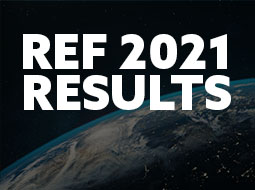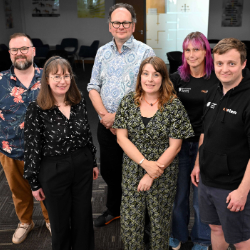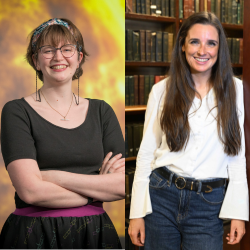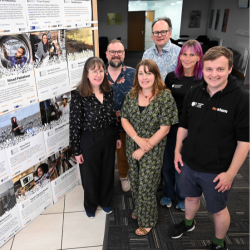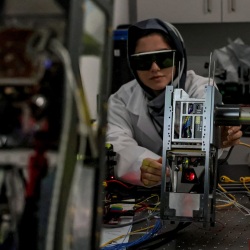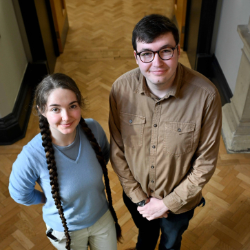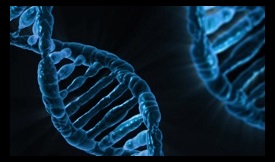Seminars take place on Wednesdays at 3pm in ELA 001, unless indicated otherwise. For any question about this seminar series, please contact Dr Remy Dubertrand.
20 August 2025
Prof. Akira Shudo, Tokyo Metropolitan University.
WKB approximation and resurgence theory
17 September 2025 (Leverhulme Lecture). Room ELA002.
Prof. Mark Hoefer, University of Colorado Boulder.
Modulation theory for two-dimensional nonlinear wave interactions
Abstract:
Interactions of multidimensional nonlinear waves are ubiquitous in geophysical fluid dynamics such as shallow water waves and internal gravity waves. In this talk, the Kadomtsev-Petviashvili (KP) equation will be analysed to investigate several complex wave interaction problems that involve linear wavepackets, solitary waves, and rarefaction/dispersive shock waves. From wave-mean flow interactions to the Mach reflection of dispersive shock waves, modulation theory will be shown to be a powerful analytical tool to characterize the dynamics. The theoretical predictions will be shown to agree quantitatively with numerical simulations of the KP equation.
24 September 2025
Achilleas Lazarides, Loughborough University.
TBC
Abstract:
8 October 2025
Prof. Yan Fyodorov, King's College London.
Kac-Rice inspired approach to non-Hermitian random matrices
Abstract:
We will discuss a method of analyzing the joint probability density (JPD) of an eigenvalue z and the associated right eigenvector v (normalized with v* v=1) for non-Hermitian random matrices of a given size N by N.
To illustrate utility of the general method I will derive and analyze the JPD for two particular examples:
(i) one-parameter family of matrices interpolating between complex Ginibre and real Ginibre ensembles and
(ii) a complex Ginibre matrix additively perturbed by a fixed matrix.
In particular, in the former case I will discuss the formation of an excess of eigenvalues in the vicinity of the real axis on approaching the real Ginibre limit, which eventually gives rise to the existence of a new scaling regime of "weak non-reality" as N goes to infinity. In the second case after providing general JPD I will briefly discuss a particular case of non-Hermitian Rosenzweig-Porter model which recently attracted considerable interest in physics literature. If time allows, I will discuss a generalization of the proposed method which is expected to be suitable for analysis of JPD involving both left- and right eigenvectors.
15 October 2025
Stefan Ruschel, Leeds University.
Master stability for traveling waves on networks
Abstract:
I will present a new framework for determining effectively the spectrum and stability of traveling waves on
networks with symmetries, such as rings and lattices, by computing master stability curves (MSCs). Unlike
traditional methods, MSCs are independent of system size and can be readily used to assess wave
destabilization and multi-stability in small and large networks.
Seminars 2024-2025
30 November 2024
Annalisa Calini, College of Charleston.
Rogue Waves in Nonlinear Schrödinger Models
Abstract:
This talk concerns rogue wave formation in realistic models of wave dynamics in deep water. Rogue waves are high amplitude waves that appear suddenly and unexpectedly, and then disappear without a trace in a variety of water conditions: deep and shallow water, calm and wind-swept seas, and with or without currents.
I will discuss ongoing work with Constance Schober on rogue waves modeled by heteroclinic orbits of uniform and quasi-periodic background states in nonlinear Schrödinger models of waves in deep water. The main thrusts are examining linear stability/instability, the effects of phase coalescence on wave amplification, and persistence under physically relevant perturbations. If time permits, I will mention our recent work on the effects of viscous damping on rogue wave formation and permanent downshifting, done in collaboration with our former students Lane Ellisor and Evelyn Smith.
11 December 2024
Prof. Henning Schomerus, Lancaster unviersity.
Physical manifestations of non-Hermiticity and topology in photonic systems
Abstract:
In photonic systems, gain and loss can induce intriguing effects linked to non-Hermitian and topological physics. Mathematically, eigenvalues become complex, and eigenstates are no longer orthogonal to each other. However, symmetries can pose constraints on these features.I will describe the mechanisms by which these effects manifest in physical signatures and highlight the fundamental practical limits of their observability. While active systems suffer from noise, passive systems are constrained by causality.
5 February 2025
Amos Chan, University of Lancaster.
Many-Body Quantum Chaos and the Spectral Form Factor
Abstract:
The study of spectral statistics is of importance in physics due to its simplicity, universality, and utility as a diagnosis of quantum chaos and localization. Recently, as a probe of spectral statistics, the spectral form factor (SFF) has been instrumental in pinpointing novel signatures of quantum chaos in the presence of many-body interactions [1], in demonstrating the random matrix theory behaviour of black holes [2], and in shedding light on the existence of the many-body localization phase in the thermodynamic limit [3]. In this talk, I will give an overview on the generic behavior of the SFF in closed [4] and open [5] strongly-interacting many-body quantum chaotic systems, and its experimental measurements in quantum simulators [6]. Specifically, I will report a duality between the SFF of quantum many-body chaotic systems and the partition function of classical ferromagnetic spin chains, and describe how non-Hermitian random matrix universality emerges from Hermitian quantum many-body chaotic systems.
References:
[1] AC, De Luca, and Chalker, PRL 121, 060601 (2018).
[2] Cotler et al., JHEP 1705:118 (2017).
[3] Šuntajs, Bonča, Prosen, and Vidmar, PRE 102, 062144 (2020).
[4] Shivam, De Luca, Huse, and AC, PRL 130, 140403 (2023).
[5] Li, Prosen, AC, PRL 127, 170602 (2021).
[6] Dong et al. w/ AC, PRL (2025).
26 February 2025
Nicolas Pavloff, LPTMS, Universite Paris Saclay.
Topological Pathways to Two-Dimensional Quantum Turbulence
Abstract:
I shall present a combined experimental and theoretical investigation of the formation and decay kinetics of vortices in a two-dimensional turbulent superfluid. Fundamental topological conservation laws require that the formation and annihilation of vortices also involve critical points of the velocity field, namely nodes and saddles. Identifying the simplest bifurcations underlying these processes enables to develop an effective kinetic model that closely aligns with experimental observations, and shows that different mechanisms are responsible for vortex number growth and decay.
5 March 2025
Thibault Bonnemain, Universite de Lille.
Hamiltonian formulation and aspects of integrability of generalised hydrodynamics.
Seminar will take place in ELB.003
Abstract
Generalised Hydrodynamics (GHD) describes the large-scale inhomogeneous dynamics of integrable (or close to integrable) systems in one dimension of space via an autonomous hydrodynamic equation. In this talk, I will present a general form of the GHD equation, notably allowing for integrability-breaking perturbations and spatially extended interaction kernels, and show that it constitutes an Hamiltonian system. To this end, I will introduce a Poisson bracket on functionals of the fluid (or quasi-particle) density, which is seen as our dynamical field variable. The fluid density depends on two (spatial and spectral) variables so that, contrary to the underlying microscopic system which which gives rise to GHD at large scales, the GHD equation can be seen as a (2 + 1)-dimensional classical field theory. The total energy of the underlying model is the Hamiltonian whose flow, under this Poisson bracket, generates the GHD equation. Furthermore, the system admits an infinite set of conserved quantities that are in involution for our Poisson bracket, hinting at integrability of this field theory.
12 March 2025
John Hannay, University of Bristol.
Manipulating a container full of a perfect liquid; unexpected geometry.
Abstract:
This doesn’t seem to have received much attention since Kelvin in the 1800s, possibly because although the equations are simple, solving them seems hard in general. A progressive 1D, 2D, and 3D sequence of introductory special cases, though, exposes, for a torus geometry, an unexpected ‘magic’ wall phenomenon.
26 March 2025
Alberto Villois, University of East Anglia.
Solitary waves in Dipolar Bose Einstein Condensates
Abstract:
Dipolar Bose-Einstein condensates (dBECs) exhibit a plethora of physics phenomena, from supersolidity to roton-like minimum in the elementary excitation spectrum.
In this work we first demonstrate the existence of axis-symmetric solitary waves in (quasi-)two-dimensional dBECs: these localised excitations are characterised by quantised vortex dipoles that continuously transit to vortex-free density depletions.
We then show how the presence of the roton minimum fundamentally alters the fate of such solutions when approaching the Landau's critical speed: when propagating along the polarisation direction where the roton minimum occurs, the solitary wave transits into roton excitations rather than into phonons as for standard contact-interaction BECs.
This finding suggests that Feynman’s hypothesis, conjectured for 3D superfluid liquid helium regarding the creation of rotons as fading vortex excitations, is valid in the context of 2D dBECs.
2 April 2025 (2.30pm, ELA101)
Claudia Garetto, Queen Mary London.
On higher order hyperbolic equations with variable multiplicities
Abstract:
In this talk I will present some recent results on the C∞ well-posedness of the Cauchy problem for higher order hyperbolic equations with variable multiplicities. I will discuss the connections with non-diagonalisable hyperbolic systems and how to deduce Levi conditions on the lower order terms. This work is joint with Bolys Sabitbek (QMUL).
30 April 2025
Sebastian Muller, University of Bristol.
TBC
Abstract:
If a system shows chaotic behaviour in the classical limit, this has important consequences for its quantum-mechanical properties. In particular, the energy levels of chaotic systems have universal statistical properties and show a tendency to repel. This behaviour can be phenomenologically described and predicted using averages over random matrices. However, a fuller understanding requires semiclassical methods, relating the level density to classical periodic orbits and spectral statistics to multiple sums over orbits.
I will give a broad introduction into this area, and then focus on recent work studying the effects of geometrical symmetries and spin. This includes a trace formula expressing the level density of chaotic quantum systems with symmetries and spin to periodic orbits. I will also discuss how the type of spectral statistics of chaotic systems with spin depends both on their behaviour under time reversal, and on matrix representations of their symmetries. This classification reveals surprising effects, such as spectral statistics for certain subspectra that differ from what one would expect based on the properties of the system as a whole.
This is joint work with Vaios Blatzios, Christopher Joyner and Martin Sieber (https://arxiv.org/abs/2411.12403 and a follow-up paper in preparation).
7 May 2025
Sam Draycott, University of Manchester.
Extreme wave formation due to abrupt depth transitions
Abstract:
The understanding of extreme wave formation is of critical importance for a range of offshore engineering applications. Abrupt depth transitions have been shown to be one such mechanism of generating extreme nonlinear surface waves. These depth transitions induce complex transformations owed to reflection, transmission, and refraction, together with nonlinear effects and resonance. This will talk will cover our work in this area, focusing on our current understanding of the physics, along with our experimental and numerical modelling work aimed at exploring different aspects of these environments: the physical explanation, statistics, wave breaking, wave directionality, and more recently, extension to 2D bathymetric features (inspired by the work of Prof. Emiliano Renzi). I will then discuss our plans for the future including active experiments in our new Hydrodynamics Laboratory.
21 May 2025
Boris Konopelchenko, University of Salento.
On hodograph equations method. Euler equation: solutions, gradient catastrophes, external forces and curved spaces.
Abstract:
We report on the application of the hodograph equations method to the multidimensional Euler equations describing the motion of an incoherent fluid. Three cases are considered: the homogeneous Euler equations, the Euler equations with an external force linear in velocity, and the Euler equations in curved spaces. The corresponding hodograph equations are derived, and particular multidimensional features of the solutions, including the occurrence of gradient catastrophes, are discussed.
28 May 2025
Yassir Dinar, Sultan Qaboos University, Oman.
Logarithmic Frobenius Manifolds from Adler-Gelfand-Dickey brackets
Abstract:
We explore the construction of a local Poisson bracket compatible with the second Adler-Gelfand-Dickey bracket, yielding a bi-Hamiltonian structure distinct from the classical bihamiltonian structure related to the KdV hierarchy. The dispersionless limit of this new structure gives rise to a logarithmic Dubrovin-Frobenius manifold and can be constructed equivalently on the orbits space of the standard representation of the symmetric group. In low dimensions, we demonstrate that the resulting bi-Hamiltonian structure is of topological type and it is equivalent to the one associated with the constrained KP hierarchy.
4 June 2025
Nick Gill, Open University.
Seminars 2023-2024
15th November 2023
Erik Koelink, Radboud Universiteit (Netherlands).
Abstract:
Seminars 2022-2023
25th January 2023 (ELA102b)
Sergey Dyachenko, Department of Mathematics, University at Buffalo.
Instabilities of almost limiting Stokes waves
Abstract:
The Stokes wave is a water wave that travels over a free surface of water without changing shape. When a time-varying fluid domain is mapped to a fixed geometry, such as a periodic strip in the lower half-plane, the equation for the Stokes wave is a nonlinear integro-differential ODE whose solutions are found numerically to arbitrary precision. The spectral stability of Stokes waves is studied by linearization of the equations of motion for the free surface around a Stokes wave, and studying the spectrum of the associated Fourier-Floquet-Hill (FFH) eigenvalue problem. We developed a novel approach to studying the eigenvalue spectrum by combining the conformal Hamiltonian canonical variables, the FFH technique built into a matrix-free Krylov-Schur eigenvalue solver. We report new results for the Benjamin-Feir instability as well as the high-frequency, and localized (superharmonic) instabilities of the waves close to the limiting Stokes wave.
15th February 2023 (ELA002)
Timm Kruger, University of Edinburgh.
Formation and stability of pairs of particles in inertial microfluidics
Abstract:
Inertial particle microfluidics is an emerging technology for microfluidic particle separation and manipulation. Some applications, such as flow cytometry and cell encapsulation, require the formation of stable particle trains with consistent inter-particle spacing along the flow axis. In order to understand the formation and properties of particle trains, we have investigated the formation and stability of the simplest case of particle trains - particle pairs - in straight channels under mild inertia through immersed-boundary-lattice-Boltzmann-finite-element simulations. We found that initial conditions, particle softness and size heterogeneity play important roles in the formation and stability of particle pairs. Our results demonstrate that all these factors must be considered in the design of inertial microfluidic devices for manipulating inter-particle spacing.
22nd February 2023 (ELA002)
Maia Angelova, Data Analytics Research Lab, School of Information Technology, Deakin University, Melbourne Burwood Campus.
Data-driven models for precision healthcare
Abstract:
In this talk, I will share our latest research and describe how our data-driven models, based on physical and physiological data, can assist in the early detection of insomnia and diabetes and provide a robust basis for pre-screening of individuals with wearable devices. I will consider the following case studies based on our most recent projects: (a) Glucose-insulin regulation models: glucose-insulin dynamics is central for understanding the regulation mechanisms between different organs in the human body and is key to maintain healthy life and prevent diabetes. We combine dynamical systems approach with machine learning algorithms to model the regulation between glucose and insulin and predict glucose dynamics and insulin utilisation in healthy and pre-diabetic regimes [1,2]; (b) Classification of chronic back pain from multi-modal data: we use image, questionnaires and physical activities data to classify chronic low back pain [3]. (c) Classification of insomnia and sleep from physical activities (actigraphy) data. Our models can distinguish acute from chronic insomnia and healthy sleep [4-6]. They provide a robust basis for pre-screening of insomnia with wearable devices in a home environment.
References:
1.Angelova, M., Beliakov, G., Ivanov, A. Shelyag, S. 2021. Global stability and periodicity in a glucose-insulin regulation model with a single delay. CNSNS 95, 105659, https://doi.org/10.1016/j.cnsns.2020.105659.
2. Huard, B., Bridgewater, A. and Angelova, M. 2017. Mathematical investigation of diabetically-impaired ultradian oscillations in the glucose-insulin regulation. J Theor Biol 418: 66-76, doi:10.1016/j.jtbi.2017.01.039.
3.Tagliaferri, S.D., Wilkin, T., Angelova, M. et al. Chronic back pain sub-grouped via psychosocial, brain and physical factors using machine learning. Sci Rep 12, 15194 (2022). https://doi.org/10.1038/s41598-022-19542-5.
4.Rani, S., Shelyag, S., Karmakar, C., Zhu, Ye, Fossion, R., Ellis, Jason, Drummond, S. P. A. and Angelova, M. (2022) Differentiating acute from chronic insomnia with machine learning from actigraphy time series data. Frontiers in Network Physiology, 2. p. 1036832. ISSN 2674-0109.
5.M. Angelova, C. Karmakar, Y. Zhu, S. P. A. Drummond and J. Ellis, ""Automated Method for Detecting Acute Insomnia Using Multi-Night Actigraphy Data, in IEEE Access, vol. 8, pp. 74413-74422, 2020, doi: 10.1109/ACCESS.2020.2988722.
6.Kusmakar, Shitanshu, et al. "A machine learning model for multi-night actigraphic detection of chronic insomnia: development and validation of a pre-screening tool." Royal Society open science 8.6 (2021): 202264, https://doi.org/10.1109/TBME.2018.2845865.
8th March 2023 (SAN 313)
Thibault Bonnemain, Kings College London.
Quadratic mean field games: Schrödinger and electrostatic representations
Abstract:
Mean Field Games provide a powerful theoretical framework to deal with stochastic optimization problems involving a large number of coupled subsystems. They can find applications in several fields, be it finance, economics, sociology, engineering ... Though these models are much simpler than the underlying differential games they describe in some limit, their precise behaviour is not yet fully understood. After introducing the basic tenets of the formalism, I will focus on a toy model from a particular class of games, for which there is a deep connection between the associated system of PDEs and the nonlinear Schrödinger equation. This allows me to identify limiting regimes that can be dealt with explicitly. In particular one such regime yields insight on the intrinsic forward-backward structure of Mean Field Games through a mapping to an electrostatic problem.
15th March 2023 (ELA002)
Casper Oelen, Department of Mathematical Sciences, Loughborough University.
Automorphic Lie algebras on complex tori
Abstract:
An automorphic Lie algebra is a Lie algebra of certain invariants, initially arising in the theory of integrable systems, or more specifically, in the context of algebraic reduction of Lax pairs. They are defined as follows. Let a finite group $\Gamma$ act on a compact Riemann surface and on a complex finite dimensional Lie algebra $\mathfrak{g}$, both by automorphisms. Consider the space of meromorphic maps from the Riemann surface to the Lie algebra with poles restricted to an orbit of $\Gamma$. The subspace of $\Gamma$-equivariant maps is an automorphic Lie algebra. It is an infinite dimensional Lie algebra over the complex numbers and it can be seen as a generalisation of the famous Onsager algebra. We present a classification for $\mathfrak{g} = \mathfrak{sl}_2(\mathbb{C})$, in which case it turns out that $\Gamma$ can be naturally restricted to be cyclic, dihedral or the alternating group on four symbols. We shall give a construction of normal forms for the case of $\mathfrak{g}=\mathfrak{sl}_2\mathbb{C})$, which is one of the key elements in the proof of the classification result. Finally, we will mention some applications to integrable systems. This talk is based on my PhD thesis, supervised by Sara Lombardo and Vincent Knibbeler.
29th March 2023 (ELA002)
Thomas Bothner, School of Mathematics, University of Bristol.
Bulk spacings in non-Hermitian matrix models
Abstract:
Random matrix eigenvalue spacings tend to show up in problems not directly related to random matrices: for instance, bumper to bumper distances of parked cars in a numberof roads in central London are well represented by the so-called eigenvalue bulk spacing distribution of a suitable Hermitian matrix model. In this talk we will first survey several occurrences of these Hermitian spacing distributions and afterwards try to generalise them to non-Hermitian models. As it turns out, the theory of integrable systems, especially Painlev´especial function theory, plays a crucial role in this field. Based on arXiv:2212.00525, jointwork with Alex Little (Bristol).
19th April 2023 (ELA002)
Tom Bridges, Department of Mathematics University of Surrey.
Superharmonic instability and water wave breaking
Abstract:
26th April 2023 (ELA002)
Peter Clarkson, University of Kent.
Orthogonal Polynomials, Integrable Systems and Random Matrices
Abstract:
In this talk I will discuss the relationship between orthogonal polynomials and integrable systems. The main example will involve Freud weights which have the form exp(U(x)), where U(x) is an even polynomial, which arise in the context of Hermitian matrix models and random symmetric matrix ensembles. I will describe properties of the recurrence coefficients in the three-term recurrence relation associated with the orthogonal polynomials. For Freud weights recurrence coefficients satisfy discrete equation which are members of the first discrete Painleve hierarchy, also known as the string equation, and also satisfy integrable nonlinear differential equations. This is joint work with Kerstin Jordaan (University of South Africa) and Ana Loureiro (University of Kent).
3rd May 2023 (ELA002)
Andrew Hone, Kent.
Elliptic analogues of Chebyshev polynomials
Abstract:
After reviewing some classical facts about continued fractions and orthogonal polynomials, using the Chebyshev polynomials of the 2nd kind as the main example, we present a construction of the continued fraction expansion of a function on a hyperelliptic curve of genus g. We show how this is connected to discrete integrable systems, Toda lattices and integer sequences, using the elliptic case (g=1) to illustrate the main ideas.
10th May 2023 (ELA002)
Daniel Ratliff, Northumbria.
What Can Water Waves Teach Us About Chorus Waves?
Abstract:
For over a century, the linear and nonlinear analysis of oceanic waves has led to great strides in our understanding of their evolution and phenomenology, and in turn had admitted a host of mathematics in the form of nonlinear PDEs and methods by which wave phenomena can be described elsewhere. In contrast, there is comparatively less understood and formulated for plasmas in our near-Earth environment. Here electromagnetic effects yield a whole new host of physics that can manifest throughout wave motion. One such wave family that is of interest are Whistler-Mode Chorus (WMC) waves, which are responsible for particle energisation (potentially to dangerous levels!) all the while 'singing' due to coherent frequency sweeping. What about the plasma could be causing this, how can we understand it, and could the whole process be an extreme event in disguise?
To answer these questions, we dust off our tools used in ocean waves to make progress. In doing so, we will demonstrate that wave-particle interactions are analogous to wave-mean flow ones and are at the heart of the dynamics which emerge. A combination of classical modulation theory and multiple scales point to higher order effects which are responsible for this singing behaviour, which for plasmas become comparable to leading order effects. The wavepackets which emerge alter the wave's frequency via their interaction, and thus we determine leading order estimates of the frequency chirp rate for WMC waves. We then observe via numerical observation that the singing events to kinetic energy amplification, making these more siren songs than heavenly chorus.
17th May 2023 (ELA002)
Ted Johnson, UCL.
Abstract:
24th May 2023 (ELA002)
Francesco Giglio, Glaglow.
Abstract:

